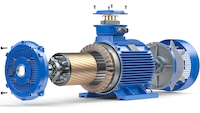
Special Physical Effects in Electric Machines
Modeling – Practical Applications – Avoiding Parasitic Effects
Introduction
The operating behavior of electric induction machines is determined by the interaction of diverse electromagnetic, mechanical, and thermal effects. Understanding the basic physical principles and calculations makes optimal design, production, and operation of electric machines as components of electric drive systems possible.
Target Audience
This seminar is intended for developers of electric machines and drive systems.
Main Topics
- Inductance and iron saturation: inductance matrices, main and stray fields, B-H and no-load curves
- Harmonic effects: magnetic field harmonics caused by splines, winding shape, pole shape, and saturation; frequencies and ordinal numbers
- Forces and torque: torque ripple, radial forces and unbalanced magnetic pull, rotor excentricity, axial forces
- Current suppression (skin effect): conductor and rod current distribution, frequency dependence, inductance and resistance changes, auto-start with deep-bar and double-bar rotors, conductive wire for stator winding
- Losses: copper losses with consideration of current suppression, harmonic losses in the cage rotor and solid rotor pole as well as PM material, metal hysteresis losses, additional losses
- Noise: caused by field and current harmonics, frequencies depend on the design
- Thermal processes: introduction
Objectives
Seminar participants will receive an overview of the basic principles of physical effects in electric rotary machines, such as magnetic iron saturation, current suppression, and field harmonics. The focus is on their influence on steady-state and transient machine operating behavior, with explanation of the key mathematical models and analytical formulas. Tips will also be given for reducing the negative influence of these effects (e.g., additional losses). Furthermore, methods will be presented for efficient utilization of certain effects to improve the operating behavior (e.g., start-up with deep-bar rotors). Practical examples have been specified for the following machine types: permanent magnet synchronous machines, induction machines, salient pole synchronous machines.
Instructors
Olga Korolova
ProFluxx GmbH
www.profluxx.com
